Frankfurt Airport
Frankfurt am Main Airport (IATA: FRA, ICAO: EDDF) (German: Flughafen Frankfurt am Main [ˈfluːkhaːfn̩ ˌfʁaŋkfʊʁt ʔam ˈmaɪn], also known as Rhein-Main-Flughafen) is a major international airport located in Frankfurt, the fifth-largest city of Germany and one of the world's leading financial centres. It is operated by Fraport and serves as the main hub for Lufthansa including Lufthansa CityLine and Lufthansa Cargo as well as Condor and AeroLogic. The airport covers an area of 2,300 hectares (5,683 acres) of land[5] and features two passenger terminals with a capacity of approximately 65 million passengers per year, four runways and extensive logistics and maintenance facilities.
Frankfurt Airport Flughafen Frankfurt am Main | |||||||||||||||||||||||
|---|---|---|---|---|---|---|---|---|---|---|---|---|---|---|---|---|---|---|---|---|---|---|---|
 | |||||||||||||||||||||||
| |||||||||||||||||||||||
| Summary | |||||||||||||||||||||||
| Airport type | Public | ||||||||||||||||||||||
| Owner/Operator | Fraport | ||||||||||||||||||||||
| Serves | Frankfurt, Germany | ||||||||||||||||||||||
| Location | Near Kelsterbach, Frankfurt | ||||||||||||||||||||||
| Hub for |
| ||||||||||||||||||||||
| Focus city for |
| ||||||||||||||||||||||
| Elevation AMSL | 364 ft / 111 m | ||||||||||||||||||||||
| Coordinates | 50°02′00″N 008°34′14″E | ||||||||||||||||||||||
| Website | frankfurt-airport.com | ||||||||||||||||||||||
| Map | |||||||||||||||||||||||
 FRA Location within Germany  FRA FRA (Europe) | |||||||||||||||||||||||
| Runways | |||||||||||||||||||||||
| |||||||||||||||||||||||
| Statistics (2019) | |||||||||||||||||||||||
| |||||||||||||||||||||||
Frankfurt Airport is the busiest airport by passenger traffic in Germany as well as the 4th busiest in Europe after London Heathrow Airport, Paris–Charles de Gaulle Airport and Amsterdam Airport Schiphol. The airport is also the 13th busiest worldwide by total number of passengers in 2016,[6] with 60.786 million passengers using the airport in 2016. In 2017 Frankfurt Airport handled 64.5 million passengers and in 2018 nearly 70 million. It also had a freight throughput of 2.076 million metric tonnes in 2015 and is the busiest airport in Europe by cargo traffic. As of summer 2017, Frankfurt Airport serves more than 300 destinations in 5 continents, making it the airport with the most direct routes in the world.[7][8]
The southern side of the airport ground was home to the Rhein-Main Air Base, which was a major air base for the United States from 1947 until 2005, when the air base was closed and the property was acquired by Fraport. In 2017, passengers at the airport increased by 6.1% to 64,500,386 compared to 2016. The airport celebrated its 80th anniversary in July 2016.[9]
Location
Frankfurt Airport lies 12 km (7.5 mi) southwest of central Frankfurt,[3] near the Autobahn intersection Frankfurter Kreuz, where two of the most heavily used motorways in Europe (A3 and A5) meet. The airport grounds, which form a city district of Frankfurt named Frankfurt-Flughafen, are surrounded by the Frankfurt City Forest. The southern portion of the airport grounds extend partially into the cities of Rüsselsheim am Main and Mörfelden-Walldorf, and a western portion of the grounds lie within the city of Kelsterbach.
The airport is centrally located in the Frankfurt/Rhine-Main region, Germany's third-largest metropolitan region, which itself has a central location in the densely populated region of the west-central European megalopolis. Thereby, along with a strong rail and motorway connection, the airport serves as a major transport node for the greater region, less than two hours by ground to Cologne, the Ruhr Area, and Stuttgart.
History
The base opened as a German commercial airport in 1936, with the northern part of the base used as a field for fixed-wing aircraft and the extreme southern part near Zeppelinheim serving as a base for rigid airships. That section of Rhein-Main later became the base for the Graf Zeppelin, its sister ship LZ-130, and, until 6 May 1937, for the ill-fated Hindenburg.
The airships were dismantled and their huge hangars demolished on 6 May 1940 during conversion of the base to military use. Luftwaffe engineers subsequently extended the single runway and erected hangars and other facilities for German military aircraft. During World War II the Luftwaffe used the field sporadically as a fighter base and as an experimental station for jet aircraft.
First airport
On 16 November 1909, the world's first airline was founded in Frankfurt am Main: The Deutsche Luftschiffahrts-Aktiengesellschaft (DELAG). DELAG then built the first airport in Frankfurt, called Airship Base at Rebstock, which was located in Bockenheim in the western part of the city and was primarily used for airships in the beginning. It opened in 1912 and was extended after World War I, but in 1924 an expert's report already questioned the possibility of further expansions at this location.
With the foundation of Deutsche Luft Hansa in 1926 a rapid boom of civilian air travel started and soon the airship base became too small to handle the demand. Plans for a new and larger airport located in the Frankfurt City Forest south-west of Schwanheim were approved in 1930, but were not realised due to the Great Depression. After the Machtergreifung in 1933 the government revived the plans and started the construction of the new airport.
Second airport
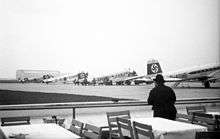
On the northern part of the airport originated in 1935 a two-storey station building with a six-storey tower, and other operating and outbuildings for maintenance and storage of aircraft. The approximately 100 hectares runway received a grass cover.
The official opening of the new Flug- und Luftschiffhafen Rhein-Main took place on 8 July 1936. The first plane that landed was a Ju 52/3m, Six days later, on 14 July 1936 LZ 127 Graf Zeppelin landed at the airport. 1936 800 tons of cargo and 58,000 passengers were transported, in 1937 70,000 passengers and 966 tons of cargo. In the coming years, the new airport was home base of the two largest German airships LZ 127 Graf Zeppelin and LZ 129 Hindenburg . In 1938 Frankfurt was a central distribution point for the transport of airmail to North America.
On 6 May 1937, the Hindenburg, flying from Frankfurt to New York, exploded shortly before it was scheduled to dock at Lakehurst. 36 people died. The accident marked the end of scheduled airship traffic and the end of the airship era.
World War II
After the beginning of World War II in 1939 all foreign airlines left the airport and control of air traffic was transferred to the Luftwaffe. On 9 May 1940, the first bombers took off to attack France. From August to November 1944 a concentration camp was established in Walldorf, close to the airport site, where Jewish female prisoners were forced to work for the airport. The Allies of World War II destroyed the runway system with airstrikes in 1944 and the Wehrmacht blew up buildings and fuel depots in 1945, shortly before the US Army took control of the airport on 25 March 1945. After the German Instrument of Surrender the war in Europe ended and the US Army started to build a new temporary runway at Frankfurt Airport. The southern part of the airport ground was occupied to build the Rhein-Main Air Base as an Air Force Base for the United States Air Forces in Europe.
Berlin Airlift
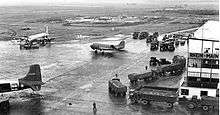
In 1948, the Soviet Union blocked the Western Allies' rail and road access to the sectors of West Berlin under Allied control. Their aim was to force the western powers to allow the Soviet zone to start supplying Berlin with food and fuel, thereby giving the Soviets practical control over the entire city. In response, the Western Allies organised the Berlin Airlift to carry supplies via air to the people in West Berlin. The airports in Frankfurt, Hamburg and Hannover were the primary bases for Allied aircraft. The heavy use of these so-called "Raisin Bombers" caused damage to the runway in Frankfurt and forced the US Army to build a second parallel runway. The airlift ended in September 1949 after the Soviet Union ended their blockade.
Growth of the airport
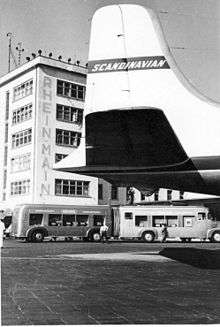
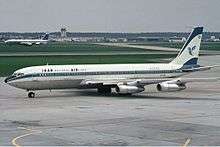
In 1951, restrictions for German air travellers were lifted and civil air traffic started to grow again. In 1952, Frankfurt Airport handled more than 400,000 passengers; a year later it was more than half a million. About 100 to 120 aeroplanes took off from and landed in Frankfurt daily. In 1955, Lufthansa resumed flights to and from Frankfurt and in the same year the Federal Republic of Germany gained its air sovereignty back from the Allies. In 1957, the northern runway was extended, first to 3,000 m (9,843 ft) and then to 3,900 m (12,795 ft), to make it compatible with jet aircraft.
The airport did not emerge as a major international airline hub until 1958 when a new passenger terminal called Empfangsanlage Ost (Terminal East, literally "Arrival Facility East") opened in the north-east corner of the airport site. Only four years later it was clear that the terminal was already too small for the demand. In 1961, Frankfurt already had 2.2 million passengers and 81,000 take-offs and landings, making it the second busiest airport in Europe behind Heathrow Airport, London.
In 1962, it was decided to build an even larger terminal with a capacity of 30 million passengers per year. Work on this terminal began in 1965. The southern runway was extended to 3,750 m (12,303 ft) in 1964. In 1970, a new hangar was inaugurated; this accommodated six jet aircraft and was the world's largest hangar at the time.
The new main terminal
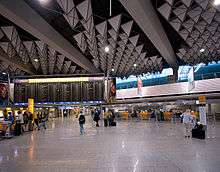
The new terminal, called Terminal Mitte (Central Terminal, today known as Terminal 1) is divided into three concourses (A, B and C) with 56 gates and an electric baggage handling system. Everything opened to the public on 14 March 1972. It was assumed that the terminal capacity would be sufficient for the next 30 years. Along with the new terminal a railway station (Frankfurt Airport station) was opened, the first airport railway station in the Federal Republic of Germany. A few days later the old Empfangsanlage Ost was closed.
The third runway
Planning for a third runway (called Startbahn 18 West) began in 1973. This project spawned massive protests by residents and environmentalists. The main points of conflict were increasing noise and pollution and the cutting down of protected trees in the Frankfurt City Forest. While the protests and related lawsuits were unsuccessful in preventing construction, the Startbahn West protests were one of the major crystallisation points for the German environmental movement of the 1980s. The protests even continued after the runway had been opened in 1984 and in 1987 two police officers were killed by a gunman. This incident ended the Startbahn West protests for good. Because of its orientation in the north–south direction, in contrast to the other east–west runways, the use of the third runway is limited. The Startbahn West can only be used for takeoffs to the south to avoid interference with air traffic on the other runways. Owing to this restriction the runway must be partially or fully closed when northward winds are too strong.
Terminal 2 and the second railway station
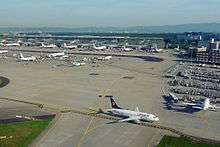
In 1990, work on a new terminal (Terminal 2) began because it was anticipated that Terminal Mitte would reach its capacity limit sooner than expected. The new terminal, divided into concourses D and E, was built to the east of the existing terminal where once the Empfangsanlage Ost had been. With its opening in 1994, Frankfurt Airport increased its terminal capacity to 54 million passengers per year. Along with the terminal opening, a people mover system called Sky Line was established to provide a fast connection between Terminal 2 and Terminal Mitte (now renamed Terminal 1).
In 1999 a second railway station, primarily for InterCityExpress long-distance trains (called Frankfurt Airport long-distance station), opened near Terminal 1 as part of the new Cologne–Frankfurt high-speed rail line. At the same time local and regional rail services were based at the existing underground station, now renamed Frankfurt Airport regional station.
Closure of the Rhein-Main Air Base
On 30 December 2005, the Rhein-Main Air Base in the southern part of the airport ground was closed and the US Air Force moved to Ramstein Air Base. The property was handed back to Fraport which allows the airport to use it to build a new passenger terminal. The property of the housing area for the soldiers, called Gateway Gardens, which was located north-east of the airport site, was given back to the city of Frankfurt in the same year and will be developed as a business district in the following years.
The Airbus A380 and The Squaire
From 2005 to 2007, a large Airbus A380 maintenance facility was built at Frankfurt Airport because Lufthansa wanted to station their future A380 aircraft fleet there. Due to economic constraints only half of the facility has been built so far. Both terminals also underwent major renovations in order to handle the A380, including the installation of a third boarding bridge at several gates. Lufthansa's first Airbus A380 went into operation in June 2010 and was named Frankfurt am Main.

In 2011, a large office building called The Squaire (a portmanteau of square and air) opened at Frankfurt Airport. It was built on top of the Airport long-distance station and is considered the largest office building in Germany with 140,000 m2 (1,500,000 sq ft) floor area. Main tenants are KPMG and two Hilton Hotels.
Since 2012, the people mover "The Squaire Metro" connects the Squaire with the nine-storey parking structure. On a length of about 300 metres the so-called MiniMetro system with its two cabins can carry up to 1,300 passengers per hour.[10] The constructor of the system was the Italian manufacturer Leitner.
The fourth runway
Plans to build a fourth runway at Frankfurt Airport were underway in 1997, but owing to violent conflicts with the concept Fraport let residents' groups and environmentalists participate in the process to find a mutually acceptable solution. In 2000, a task force presented their conclusion which generally approved a new runway, but of shorter length (only 2.8 kilometres compared to the other three 4-kilometre-long runways), which would serve as a landing-only runway for smaller aircraft. Additional requirements included improved noise protection arrangements and a strict ban on night flights between 11 pm and 5 am across the whole airport. In 2001, Fraport applied for approval to build the new runway, with three possible options. The conclusion was that a runway north-west of the airport site would have the least impact on local residents and the surrounding environment. The plans were approved by the Hessian government in December 2007, but the requested ban on night flights was lifted because it was argued that an international airport like Frankfurt would need night flights, especially for worldwide freight transport. Construction of the new 2,800 m (9,186 ft) long Runway Northwest in the Kelsterbach Forest began in early 2009.
In 2012, the website Airport Watch reports weekly protests have been occurring at the airport since the opening of a fourth runway a year previously.[11]
Developments since 2011
The new runway officially went into operation on 20 October 2011, with an aircraft carrying Chancellor Angela Merkel, performing the first landing on 21 October. The centre line separation from the existing north runway is about 1,400 m (4,593 ft). This allows simultaneous instrument landing system (ILS) operations on these two runways, which has not been possible on the other parallel runways, which do not meet the 3,500 feet (1,100 m) minimum separation for ILS operations.[12] This allowed the airport to increase its capacity from 83 to 126 aircraft movements per hour.[13][14]
On 11 October 2011, the Hessian Administration Court ruled that night flights between 11pm and 5am (the so-called Mediationsnacht) are no longer allowed at Frankfurt Airport after the inauguration of the new runway, and therefore overrode the approval from the Hessian government from 2007 which allowed 17 scheduled flights per night. On 4 April 2012, the German Administrative Court confirmed the decision of the Hessian Administration Court, banning night flights between 11pm and 5am.[15]
To handle the predicted passenger amount of about 90 million in 2020, a new terminal section adjacent to Terminal 1 for an additional six million passengers opened on 10 October 2012. It is called Flugsteig A-Plus and exclusively used by Lufthansa mainly for their long-haul flights. Flugsteig A-Plus features eight parking positions that are able to handle four Airbus A380s or seven Boeing 747-8/747-400 at once.[16]
In November 2016, Ryanair announced the opening of a new base at Frankfurt Airport with four routes to Spain and Portugal. This move by Ryanair was heavily blasted, especially by Lufthansa, as Ryanair was granted high discounts and incentives regarding the airport's fees.[17] On 28 February 2017, Ryanair announced its winter programme for Frankfurt which will see a further 20 new routes being added.
Facilities
Terminals
Frankfurt Airport has two large main passenger terminals (1 and 2) and a much smaller dedicated First Class Terminal which is operated and exclusively used by Lufthansa. As is the case at London Heathrow Airport, Los Angeles International Airport (bar the Tom Bradley International Terminal) and O'Hare Airport's's future Global Terminal, terminal operations are grouped for airlines and airline alliances rather than into domestic and international routes.
Terminal 1
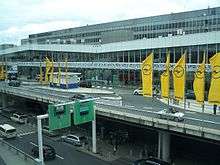
Terminal 1 is the older and larger one of the two passenger terminals. The landside is 420 metres long. It has been enlarged several times and is divided into concourses A, B, C and Z and has a capacity of approximately 50 million passengers per year. Terminal 1 is functionally divided into three levels, the departures level on the upper floor with check-in counters, the arrivals level with baggage claim areas on the ground floor and, underneath, a distribution floor with access to the regional station and underground and multilevel parking. Departures and arrivals levels each have separate street approaches. A bus station is located at arrivals level. Terminal 1 has a total of 103 gates, which include 54 gates equipped with jetways (25 in Concourse A, 18 in Concourse B, 11 in Concourse C). Concourse Z sits on top of Concourse A sharing the same jet bridges between both concourses. Flights to non-Schengen destinations depart from the Z gates and Schengen flights depart from the A gates.
Pier A was extended by 500 metres in 2000, and a link between Terminal 1 and Terminal 2, as well as the Hall C extension opened in 2008.[18]
On 10 October 2012, an 800-metre-long westward expansion of Terminal 1 called Pier A-Plus went into operation. It provides more stands for wide-body aircraft like the Airbus A380.[19]
Terminal 1 is primarily used by Lufthansa, its associated companies (Brussels Airlines, Eurowings, Swiss International Air Lines and Austrian Airlines) and its Star Alliance partners (e.g. Aegean Airlines, Air Canada, Air China, Air India, All Nippon Airways, Asiana Airlines, Croatia Airlines, LOT Polish Airlines, Scandinavian Airlines, Singapore Airlines, South African Airways, TAP Air Portugal, Thai Airways, Turkish Airlines and United Airlines).
Some airlines that are not part of the Lufthansa Group or Star Alliance also use Terminal 1. They include Air Malta, Bulgaria Air, Iran Air, Oman Air and Tunisair among others.
SkyTeam member airlines Alitalia and Middle East Airlines also use Terminal 1 (Concourses B and C).
Terminal 2

Terminal 2, which has a capacity of 15 million passengers a year, was opened in 1994 and is divided into concourses D and E. A continuous concourse between Terminal 1C and 2D provides direct, but non-public access between the two terminals. It has eight gates with jetways and 34 apron stands, a total of 42 gates and is able to handle wide-body aircraft such as the Airbus A380.
Terminal 2 is primarily used by airlines of the oneworld (e.g. American Airlines, British Airways, Cathay Pacific, Finnair, Iberia, Japan Airlines, LATAM Airlines, Malaysia Airlines, Royal Jordanian and S7 Airlines) and SkyTeam alliances (e.g. Aeroflot, Air France, China Airlines, China Eastern Airlines, Czech Airlines, Delta Air Lines, KLM, Korean Air, Saudia, TAROM and Vietnam Airlines; note that SkyTeam members Alitalia and Middle East Airlines operate out of Terminal 1, in concourses B and C).
Terminal 2 is also used by airlines that do not belong to any of the three major airline alliances, including Air Moldova, Air Serbia, China Southern Airlines, Emirates, Kuwait Airways, Royal Air Maroc and Somon Air, among others.
Terminal overview
| Terminal | Concourse | Schengen gates | Non-Schengen gates | Location |
|---|---|---|---|---|
| 1 | 1A | A1-A69 | Terminal 1, western concourse, lower departure level | |
| 1Z | Z11-Z69 | Terminal 1, western concourse, upper departure level | ||
| 1B | B1-B19 (inner area) |
B20-B63 (outer area) |
Terminal 1, central concourse | |
| 1C | C1 | C2-C20 | Terminal 1, eastern concourse | |
| 2 | 2D | D21-D44 (lower departure level) |
D1-D20/D50-D54 (upper departure level) |
Terminal 2, western concourse |
| 2E | E21-E26 (lower departure level) |
E2-E13 (upper departure level) |
Terminal 2, eastern concourse |
Lufthansa First Class Terminal
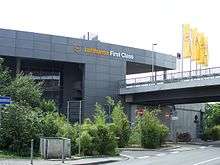
Lufthansa operates a small terminal near Terminal 1 for Lufthansa first class passengers and HON Circle frequent flyer members only. Other first class passengers must use the first class lounges within the main terminals. The facility has 200 staff and is used by about 300 passengers daily. It provides "individualised" security screening and customs facilities. Amenities include valet parking, a white-linen restaurant, lounge and office areas, a cigar room and bubble baths. Passengers are transported directly from the terminal to the plane by luxury car.
SkyLine
Passengers and visitors can change terminals with the people mover system SkyLine which has the following stops:
| Stop | Restrictions |
|---|---|
| 1AZ | passengers only |
| 1B | |
| 1C | non-Schengen passengers only |
| 2DE |
The travel time between the terminals is 2 minutes with trains arriving every 2–3 minutes during the day. Additionally there is regular bus service between the terminals.
Runways
Frankfurt Airport has four runways of which three are arranged parallel in east–west direction and one in north–south direction. In 2010 three runways (Runways North, South and West) handled 464,432 aircraft movements, which equated to 83 movements per hour. With the start of operation of the Northwest Runway in October 2011 the airport was predicted to be able to handle 126 movements per hour. It is predicted that aircraft movements will increase up to 700,000 in the year 2020. By using the fourth runway, Frankfurt Airport is able for the first time to handle simultaneous parallel landings, because the distance between the north and the north-west runways is 1,400 m (4,593 ft). Simultaneous parallel landings were not possible with the north and south runway pairing, because the separation distance did not meet the safety standards.
| Direction (Name) | Length × Width in m (ft) | Surface | Orientation | Start of operation | Use |
|---|---|---|---|---|---|
| 07C/25C (Runway North) |
4000 × 60 (13,123 × 197) |
Asphalt | East-west | 1936 | Take-offs (landings allowed) |
| 07R/25L (Runway South) |
4000 × 45 (13,123 × 148) |
Asphalt | East-west | 1949 | Take-offs and landings |
| 18 (Runway West) |
4000 × 45 (13,123 × 148) |
Concrete | North-south | 1984 | Take-offs in southbound direction only |
| 07L/25R (Runway Northwest) |
2800 × 45 (9,240 × 148) |
Concrete | East-west | 2011 | Landings only (not allowed for Airbus A380, Boeing 747, MD-11) |
During normal operation the two outer parallel runways (07L/25R and 07R/25L) are used for landings and the central parallel runway (07C/25C) and the Runway West (18) for take-offs. The three parallel runways have two markings because they can be operated in two directions while the Runway West can only be used in one direction.
Future expansions
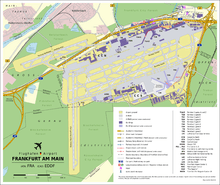
Terminal 3 (under construction)
In 2009, the German government decided to create third terminals for both Frankfurt Airport and Munich Airport in order to handle expected passenger flows of 90 million in Frankfurt by 2020 and 50 million in Munich by 2017. The new terminal is scheduled to be built by Fraport, south of the existing terminals on the grounds of the former Rhein-Main Air Base. The new Terminal 3 is to accommodate up to 25 million passengers and will feature 75 new aircraft positions when completely constructed. An extension of the SkyLine people mover system is planned to connect the new terminal to Terminals 1 and 2 and the airport train stations.
In August 2014, the city of Frankfurt granted building permission for the first phase of Terminal 3.[20] The groundbreaking for the new terminal took place on 5 October 2015. Its first phase, consisting of the main building and two of the planned four piers (concourses 3H and 3J), is planned to open by 2023 and will be able to handle 15 million additional passengers per year. Total costs are estimated at 3 billion euros.[21]
In 2017, Frankfurt Airport indicated that the second-phase construction of the eastern-most pier (concourse 3G) could be moved forward so that low-cost carriers can use this pier from 2021.[22] After approval by municipal authorities in 2018,[23] the piers will be constructed and used according to the following timetable:[24]
Concourse 3G (eastern-most pier):
- Construction of first twelve bus gates, reachable via shuttle buses from terminals 1/2, in use by 2021
- Construction of additional twelve bus gates by 2023/2024
- Construction of passenger bridges by 2025/2026
Check-in area, concourses 3H and 3J (central piers): Construction by 2023 including transport systems for visitors, passengers and luggage to the other terminals
- Concourse 3H is planned for Schengen flights
- Concourse 3J is planned for non-Schengen flights[25]
Concourse 3K (western-most pier): Possible third-phase expansion depending on development of passenger numbers
Passenger Transport System
A new passenger transport system is planned for the connection of the new terminal 3 and the existing terminals 1 and 2. It will use a track which is separate from the existing SkyLine people mover but will allow for interchanges between them.[26] It is scheduled to have four stops in the final stage:
| Stop | Location/remarks |
|---|---|
| F | Long- and short-distance railway station |
| 1C | Interchange station to SkyLine (long-term planning) |
| 2DE | Interchange station to SkyLine (upon inauguration of PTS) |
| 3GHJK |
Passenger airlines and destinations
Lufthansa and their Star Alliance partners account for 77% of all passengers at Frankfurt Airport.[27] 65% of all intercontinental flights in Germany are operated at Frankfurt Airport, followed by Munich Airport with 17%.[27] The following airlines offer year-round and seasonal scheduled and charter flights at Frankfurt Airport:[28]
| Airlines | Destinations |
|---|---|
| Aegean Airlines | Athens, Thessaloniki Seasonal: Corfu, Heraklion, Rhodes |
| Aer Lingus | Dublin |
| Aeroflot | Kazan, Moscow–Sheremetyevo |
| Air Algérie | Algiers Seasonal: Oran |
| Air Arabia Maroc | Marrakesh |
| Air Astana | Atyrau,[29] Nur-Sultan, Oral[30] |
| airBaltic | Riga |
| Air Canada | Calgary, Montréal–Trudeau, Toronto–Pearson Seasonal: Vancouver |
| Air China | Beijing–Capital, Chengdu,[31] Shanghai–Pudong, Shenzhen |
| Air Dolomiti[32] | Linz, Florence, Turin, Verona |
| Air Europa | Madrid |
| Air France | Paris–Charles de Gaulle |
| Air India | Delhi, Mumbai[33] |
| Air Malta | Malta[34] |
| Air Moldova | Chişinău |
| Air Namibia | Windhoek–Hosea Kutako |
| Air Serbia | Belgrade |
| Albawings | Tirana (begins 8 June 2020)[35] |
| Alitalia | Milan–Linate, Rome–Fiumicino |
| All Nippon Airways | Tokyo–Haneda |
| American Airlines | Charlotte, Dallas/Fort Worth |
| AnadoluJet | Ankara, Istanbul–Sabiha Gökçen[36] |
| Asiana Airlines | Seoul–Incheon |
| Austrian Airlines | Innsbruck, Vienna |
| Azores Airlines | Ponta Delgada |
| Belavia | Minsk |
| British Airways | London–City, London–Heathrow |
| Bulgaria Air | Sofia |
| Cathay Pacific | Hong Kong |
| China Airlines | Taipei–Taoyuan |
| China Eastern Airlines | Shanghai–Pudong |
| China Southern Airlines | Guangzhou |
| Condor[37] | Agadir, Barbados, Cancún, Fuerteventura, Funchal, Havana, Holguín, Hurghada, Kilimanjaro, Lanzarote, La Palma, Las Vegas, Mahé, Malé, Mauritius, Mombasa, Montego Bay, Palma de Mallorca, Paphos,[38] Puerto Plata, Punta Cana, San José (CR), San Juan, Santo Domingo, Seattle/Tacoma, Tenerife–South, Tobago, Varadero, Windhoek–Hosea Kutako, Zanzibar Seasonal: Anchorage, Antalya, Baltimore, Cagliari, Calgary, Cape Town, Catania, Chania, Corfu, Curaçao, Dalaman, Dubrovnik, Edmonton (begins 1 June 2020),[39] Fairbanks, Grenada, Halifax, Heraklion, Ibiza, Jerez de la Frontera, Kalamata, Kavala, Kos, Lamezia Terme, Larnaca, Minneapolis/St. Paul, Mykonos, New Orleans, Olbia, Phoenix–Sky Harbor, Pittsburgh, Portland (OR), Preveza/Lefkada, Rhodes, Samos, Santorini, Skiathos, Split, Thessaloniki, Tivat (resumes 1 May 2020),[40] Toronto–Pearson, Toulon (begins 20 May 2020),[41] Vancouver, Whitehorse, Zadar, Zakynthos Seasonal charter: La Romana,[42] Samaná[43] |
| Corendon Airlines[44] | Antalya, Izmir Seasonal: Bodrum (begins 30 May 2020),[45] Gazipaşa, Kayseri (begins 25 May 2020)[44] |
| Corendon Airlines Europe | Seasonal charter: Banjul[46] |
| Croatia Airlines | Dubrovnik, Split, Zagreb Seasonal: Pula, Zadar |
| Czech Airlines | Prague |
| Delta Air Lines | Atlanta, Detroit, New York–JFK |
| EgyptAir | Cairo |
| El Al | Tel Aviv |
| Emirates | Dubai–International |
| Ethiopian Airlines | Addis Ababa |
| Etihad Airways | Abu Dhabi |
| Eurowings[47] | Las Vegas,[48] Pristina,[49] Windhoek–Hosea Kutako Seasonal: Barbados, Calgary (begins June 1, 2020), Mauritius |
| Finnair | Helsinki |
| Gulf Air | Bahrain |
| Holiday Europe | Seasonal charter: Fuerteventura,[50] Hurghada, Marsa Alam,[51] Sharm El Sheikh[51] |
| Iberia | Madrid |
| Iberia Regional | Madrid |
| Icelandair | Reykjavík–Keflavík |
| Iran Air | Tehran–Imam Khomeini |
| Iraqi Airways | Baghdad, Sulaymaniyah[52] |
| Japan Airlines | Tokyo–Narita |
| KLM | Amsterdam |
| Korean Air | Seoul–Incheon |
| Kuwait Airways | Kuwait |
| LATAM Brasil | São Paulo–Guarulhos |
| LATAM Chile | Madrid (ends 30 June 2020),[53] Santiago de Chile |
| Lauda[54] | Seasonal: Palma de Mallorca |
| LOT Polish Airlines | Warsaw–Chopin |
| Lufthansa[55] | Abuja, Addis Ababa, Agadir, Alicante, Algiers, Almaty, Amman–Queen Alia, Amsterdam, Antalya, Athens, Atlanta, Austin, Bahrain, Baku, Bangkok–Suvarnabhumi, Barcelona, Bari, Basel/Mulhouse, Beijing–Capital, Beirut, Belgrade, Bangalore, Berlin–Tegel, Bilbao, Billund, Birmingham, Bogotá, Bologna, Bordeaux, Boston, Bremen, Bristol,[55] Brussels, Bucharest, Budapest, Buenos Aires–Ezeiza, Bydgoszcz, Cairo, Cancún, Cape Town, Casablanca, Catania, Chennai, Chicago–O'Hare, Chișinău, Cluj-Napoca, Copenhagen, Dallas/Fort Worth, Dammam, Delhi, Denver, Detroit, Dresden, Dubai–International, Dublin, Düsseldorf, Edinburgh, Erbil, Faro, Friedrichshafen, Funchal, Gdańsk, Geneva, Glasgow, Gothenburg, Graz, Hamburg, Hanover, Helsinki, Hong Kong, Houston–Intercontinental, Istanbul, Johannesburg–O. R. Tambo, Katowice, Kiev–Boryspil, Kraków, Kuwait, Lagos, Larnaca, Leipzig/Halle, Linz, Lisbon, Ljubljana, London–City, London–Heathrow, Los Angeles, Luanda, Luxembourg, Lyon, Madrid, Malabo, Málaga, Malta, Manchester, Marrakesh, Marseille, Mexico City, Miami, Milan–Linate, Milan–Malpensa, Minsk, Moscow–Domodedovo, Mumbai, Munich, Münster/Osnabrück, Nairobi–Jomo Kenyatta, Nagoya–Centrair, Nanjing, Naples, Newark, New York–JFK, Nice, Nuremberg, Nur-Sultan, Orlando, Oslo–Gardermoen, Palermo, Pamplona, Panama City, Paris–Charles de Gaulle, Philadelphia, Port Harcourt, Porto, Poznań, Prague, Qingdao, Reykjavík–Keflavík, Riga, Rio de Janeiro–Galeão, Riyadh, Rome–Fiumicino, Saint Petersburg, Salzburg, San Diego, San Francisco, San Jose (CR), Santiago de Compostela, São Paulo–Guarulhos, Seattle/Tacoma, Seoul–Incheon, Seville, Shanghai–Pudong, Shenyang, Singapore, Sofia, Stockholm–Arlanda, Stuttgart, Sylt, Tallinn, Tampa, Tehran–Imam Khomeini, Tel Aviv, Thessaloniki, Timișoara, Tirana, Tokyo–Haneda, Toronto–Pearson, Toulouse, Trieste, Tunis, Valencia, Vancouver, Venice, Vienna, Vilnius, Warsaw–Chopin, Washington–Dulles, Wrocław, Zagreb, Zurich Seasonal: Bastia, Bodrum, Cagliari, Dubrovnik, Eilat, Heraklion, Heringsdorf, Hévíz–Balaton, Ibiza, Ivalo, Kuusamo, Malé, Menorca, Montréal–Trudeau, Olbia, Ottawa (begins May 16, 2020), Palma de Mallorca, Pula, Rennes ,[56] Santorini, Shannon, Split, Tivat, Tromsø, Zadar |
| MIAT Mongolian Airlines | Seasonal: Ulaanbaatar |
| Middle East Airlines | Beirut |
| Montenegro Airlines | Podgorica |
| Oman Air | Muscat |
| Onur Air | Antalya[57] Seasonal: Istanbul |
| Pegasus Airlines | Antalya (resumes 9 June 2020),[58] Istanbul–Sabiha Gökçen |
| Qatar Airways | Doha |
| Royal Air Maroc | Casablanca, Nador |
| Royal Jordanian | Amman–Queen Alia |
| Ryanair | Alicante, Barcelona, Bergamo, Brindisi, Catania, Dublin, Faro, Kraków, Lanzarote, London–Stansted, Málaga, Palma de Mallorca, Porto, Tenerife–South, Valencia Seasonal: Athens, Chania, Corfu, Kefalonia, Mykonos, Pisa, Seville |
| S7 Airlines | Seasonal: Novosibirsk[59] |
| Saudia | Jeddah, Riyadh Seasonal: Medina |
| Scandinavian Airlines | Copenhagen, Oslo–Gardermoen, Stockholm–Arlanda |
| Singapore Airlines | New York–JFK, Singapore |
| Somon Air | Dushanbe |
| South African Airways | Johannesburg–O. R. Tambo |
| SunExpress | Antalya, Dalaman, İzmir Seasonal: Ordu–Giresun |
| SunExpress Deutschland | Adana, Agadir, Ankara, Antalya, Chania, Gazipaşa, Hurghada, Ibiza, İzmir, Lamezia Terme, Lanzarote, Luxor, Marsa Alam, Palma de Mallorca, Sharm El Sheikh Seasonal: Burgas, Corfu (begins 5 May 2020),[60] Heraklion,[61] Malatya (begins 23 June 2020),[62] Samsun, Varna |
| Swiss International Air Lines | Geneva, Zurich |
| TAP Air Portugal | Lisbon |
| TAROM | Bucharest |
| Thai Airways | Bangkok–Suvarnabhumi Seasonal: Phuket |
| TUI fly Deutschland[63] | Agadir,[64] Barcelona,[65] Boa Vista, Fuerteventura, Gran Canaria, Hurghada, Lanzarote, Marsa Alam, Sal, Tenerife–South Seasonal: Antalya, Corfu, Dalaman, Djerba, Enfidha, Faro, Funchal, Heraklion, Ibiza, Jerez de la Frontera, Kos, Lamezia Terme, Larnaca, Menorca, Palma de Mallorca, Patras, Rhodes |
| Tunisair | Djerba, Tunis |
| Turkish Airlines | Istanbul Seasonal: Adana, Antalya (resumes 4 June 2020),[66] Kayseri, Izmir |
| Turkmenistan Airlines | Ashgabat[67][68] |
| Ukraine International Airlines | Kiev–Boryspil |
| United Airlines | Chicago–O'Hare, Denver, Houston–Intercontinental, Newark, San Francisco, Washington–Dulles |
| Ural Airlines | Moscow–Domodedovo,[69] Saint Petersburg[69] |
| Uzbekistan Airways | Tashkent Seasonal: Urgench[70] |
| Vietnam Airlines | Hanoi, Ho Chi Minh City |
| Wizz Air | Budapest (ends 30 April 2020), Kiev–Zhuliany (ends 30 April 2020)[71] |
Cargo airlines and destinations
Frankfurt Airport is the second-largest multimodal transport airport in Europe and has several logistics facilities. These facilities are grouped at two areas at the airport ground: In the north (CargoCity Nord) and in the south (CargoCity Süd). In 2010 it was the second-busiest airport by cargo traffic in Europe after Paris–Charles de Gaulle Airport, handling 2,231,348 metric tonnes of loaded and unloaded freight.
The following airlines operate regular scheduled cargo operations at Frankfurt Airport:
| Airlines | Destinations |
|---|---|
| Air ACT | Istanbul–Sabiha Gökçen |
| Air Algérie Cargo | Algiers |
| Air China Cargo | Beijing–Capital, Shanghai–Pudong |
| AirBridgeCargo | Dallas/Fort Worth, Helsinki, Los Angeles, Moscow–Domodedovo, Moscow–Sheremetyevo, Yekaterinburg |
| Asiana Cargo | Göteborg, Moscow–Domodedovo, Seoul–Incheon, Vienna |
| ASL Airlines Belgium | Dubai–International, Liège |
| Cathay Pacific Cargo | Amsterdam, Chennai, Dubai–International, Hong Kong, Manchester, Mumbai, Paris–Charles de Gaulle |
| China Airlines | Abu Dhabi, Prague, Taipei–Taoyuan |
| China Cargo Airlines | Shanghai–Pudong[72] |
| China Southern Airlines | Guangzhou, Shanghai–Pudong |
| DHL Aviation | Ashgabat, Hong Kong, Leipzig/Halle, London–Heathrow, Tehran–Imam Khomeini |
| Emirates SkyCargo | Cairo, Campinas–Viracopos, Dakar–Senghor, Dubai–Al Maktoum, Mexico City, Tripoli |
| Etihad Cargo[73] | Abu Dhabi,[73] Bogotá,[73] Bridgetown[73] |
| FedEx Express | Cologne/Bonn, Memphis |
| FedEx Feeder | Paris–Charles de Gaulle |
| Iran Air Cargo | Tehran-Mehrabad |
| Korean Air Cargo | Brussels, Moscow–Sheremetyevo, Navoi, Seoul–Incheon, Stockholm–Arlanda, Tel Aviv |
| LATAM Cargo Chile | Amsterdam, Campinas–Viracopos |
| Lufthansa Cargo | Aguadilla, Almaty, Amsterdam, Atlanta, Bahrain, Bangalore, Bangkok–Suvarnabhumi, Beijing–Capital, Bogotá, Boston, Buenos Aires, Cairo, Campinas, Chennai, Chicago–O'Hare, Chongqing, Cologne/Bonn, Curitiba, Dakar–Senghor, Dallas/Fort Worth, Delhi, Dhaka, Guangzhou, Hong Kong, Houston, Hyderabad, Istanbul–Atatürk, Jakarta–Soekarno–Hatta, Jeddah, Johannesburg–O. R. Tambo, Kaunas, Los Angeles, Manaus, Manchester, Mexico City, Miami,[74] Moscow–Sheremetyevo, Mumbai, Nairobi, New York–JFK, Novosibirsk, Osaka–Kansai, Quito, Rio de Janeiro–Galeão, Riyadh, Seoul–Incheon, Shanghai–Pudong, Shannon, Sharjah, Shenyang, Shenzhen, Tehran–Imam Khomeini, Tel Aviv, Tokyo–Narita, Toronto–Pearson, Tucumán |
| Maximus Air Cargo | Sharjah |
| National Airlines | Doha, Hong Kong, Karaganda, Kuwait, Quetta |
| Qatar Airways Cargo | Doha[75] |
| RAM Cargo | London–Gatwick, Madrid |
| Saudia Cargo | Dammam, Riyadh |
| Turkish Cargo | Istanbul–Atatürk, Lagos |
CargoCity
CargoCity is the name of the two large main areas featuring most of the airport's freight handling facilities:
- The 98 hectare large CargoCity Süd (South) is home to a cargo centre for dispatch service providers and freight forwarding businesses. Several transport companies like DHL Global Forwarding, Air China, Emirates, Japan Airlines, Cathay Pacific, Korean Air and Fraport Cargo Services are based here.
- CargoCity Nord (North) is the headquarters of Lufthansa Cargo. Additional facilities here are a Perishables Centre for fresh produced goods and the Frankfurt Animal Lounge for the transport of living animals.
Other facilities
Airport City
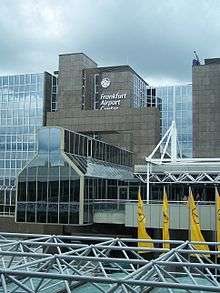

The airport ground and the surrounding area of Frankfurt Airport offer a large variety of on-airport businesses as well as airport-related businesses, including office space, hotels, shopping areas, conference rooms and car parks. The development of an airport city has significantly accelerated in recent years.
Frankfurt Airport Centres
The Frankfurt Airport Centre 1 (FAC 1) near Terminal 1 offers office and conference facilities, the newer FAC 2 is located within Terminal 2 and offers office space for airlines.
Airport City Mall
The Airport City Mall is located on the landside of Terminal 1, departure hall B. It offers national and international retailers and label stores, a supermarket and several restaurants.
The Squaire
The Squaire is an office building with a total floor area of 140,000 m2 (1,506,900 sq ft). It is directly connected to Terminal 1 through a connecting corridor for pedestrians. The accounting firm KPMG, Lufthansa and two Hilton Hotels (Hilton Garden Inn Frankfurt Airport with 334 rooms and Hilton Frankfurt Airport with 249 rooms) occupy space in The Squaire.
Main Airport Centre
The Main Airport Centre, named after the Main river, is an office building with ten floors and about 51,000 m2 (549,000 sq ft) of office space. It is located at the edge of the Frankfurt City Forest near Terminal 2.
Sheraton Hotel & Conference Centre
Sheraton Hotels and Resorts offers 1,008 guest rooms adjacent to Terminal 1 and a conference centre for up to 200 delegates.
Gateway Gardens
Gateway Gardens is a former housing area for the US Air Force personnel based at the Rhein-Main Air Base, close to Terminal 2. Like the air base, the housing area was closed in 2005. Since then the area is being developed into a business location for airport-related companies. Lufthansa moved its airline catering subsidiary LSG Sky Chefs to Gateway Gardens, Condor and SunExpress are headquartered here. DB Schenker, the logistics company of Deutsche Bahn, have built a 66 m (217 ft) high-rise building.
In December 2019, local trains were re-routed to run via Gateway Gardens station. The new stop for S-Bahn trains is located between Frankfurt Airport Regional Station and Frankfurt-Stadion station. The journey time will increase by 4 minutes but Deutsche Bahn have stated that they will use new trains (ET423) which will be faster and have more capacity.[76]
Further users

- Fraport's facilities are on the property of Frankfurt Airport.[77] Its head office building is by Gate 3.[78] The newly constructed[79] headquarters were inaugurated there in 2012.[80] The Fraport Driving School (Fraport Fahrschule) is in Building 501 of CargoCity South (CargoCity Süd).[81][82]
- Lufthansa's main building, where the board of directors is seated, is called Lufthansa Aviation Centre (LAC).[83] Lufthansa operates the Lufthansa Aviation Center (LAC), Building 366 at Frankfurt Airport.[84][85] Several company departments, including Corporate Communications,[86] Investor Relations,[87] and Media Relations,[88] are based at the LAC. Lufthansa also uses several other buildings in the area, including the Lufthansa Flight Training Center for flight training operations and the Lufthansa Basis BG2[89] as a central base and for crew briefing. As of 2011 Lufthansa Cargo has been headquartered in Building 451 of the Frankfurt Airport area.[90] As of 2012 Lufthansa Cargo is located at Gate 25 in the CargoCity Nord area, Lufthansa Technik is located at Gate 23 and in the CargoCity Süd area.[91]
- Star Alliance, an airline alliance, has its headquarters at the Frankfurt Airport Centre 1 (FAC 1) adjacent to Terminal 1.[92]
- Airmail Centre Frankfurt, a joint venture of Lufthansa Cargo, Fraport, and Deutsche Post for airmail transport, has its head office in Building 189, between Terminals 1 and 2.[93]
- Aero Lloyd previously had its head office in Building 182.[94][95]
Statistics
Annual traffic
| Year | Passengers | % Change |
|---|---|---|
| 2000 | 49,360,620 | |
| 2001 | 48,559,980 | |
| 2002 | 48,450,356 | |
| 2003 | 48,351,664 | |
| 2004 | 51,098,271 | |
| 2005 | 52,219,412 | |
| 2006 | 52,810,683 | |
| 2007 | 54,161,856 | |
| 2008 | 53,467,450 | |
| 2009 | 50,932,840 | |
| 2010 | 53,009,221 | |
| 2011 | 56,436,255 | |
| 2012 | 57,520,001 | |
| 2013 | 58,036,948 | |
| 2014 | 59,570,000 | |
| 2015 | 61,032,022 | |
| 2016 | 60,792,308 | |
| 2017 | 64,500,386 | |
| 2018 | 69,514,414 | |
| 2019 | 70,560,987 |
Route statistics
| Rank | Destination | Departing passengers | Operating airlines |
|---|---|---|---|
| 1 | Berlin–Tegel | 802,000 | Lufthansa, Air Berlin |
| 2 | Hamburg | 745,100 | Lufthansa |
| 3 | London–Heathrow | 639,500 | British Airways, Lufthansa |
| 4 | Zurich | 621,070 | Lufthansa, Swiss International Air Lines |
| 5 | Vienna | 484,200 | Austrian Airlines, Lufthansa |
| 6 | Munich | 475,100 | Lufthansa |
| 7 | Madrid | 459,400 | Iberia, LAN Airlines, Lufthansa, Air Europa |
| 8 | Chicago–O'Hare | 451,700 | Lufthansa, United Airlines |
| 9 | Paris–Charles de Gaulle | 448,200 | Air France, Lufthansa |
| 10 | Singapore | 429,500 | Lufthansa, Singapore Airlines |
| Rank | Destination | All passengers | Operating airlines |
|---|---|---|---|
| 1 | Berlin–Tegel | 1,956,370 | Easyjet, Lufthansa |
| 2 | Hamburg | 1,394,973 | Lufthansa |
| 3 | Munich | 1,178,482 | Lufthansa |
| 4 | Düsseldorf | 425,076 | Lufthansa |
| 5 | Stuttgart | 384,614 | Lufthansa |
| Rank | Destination | All passengers | Operating airlines |
|---|---|---|---|
| 1 | London–Heathrow | 1,494,467 | British Airways, Lufthansa |
| 2 | Vienna | 1,180,693 | Austrian Airlines, Lufthansa |
| 3 | Madrid | 1,052,236 | Air Europa, Iberia, LATAM Chile, Lufthansa, Ryanair |
| 4 | Paris–Charles de Gaulle | 944,089 | Air France, Lufthansa |
| 5 | Barcelona | 931,595 | Lufthansa, Ryanair |
| Rank | Destination | All passengers | Operating airlines |
|---|---|---|---|
| 1 | Dubai–International | 1,085,976 | Emirates, Lufthansa |
| 2 | New York–JFK | 958,734 | Delta Air Lines, Lufthansa, Singapore Airlines |
| 3 | Shanghai–Pudong | 814,752 | Air China, China Eastern Airlines, Lufthansa |
| 4 | Seoul–Incheon | 702,581 | Asiana Airlines, Korean Air, Lufthansa |
| 5 | Toronto–Pearson | 693,031 | Air Canada, Lufthansa |
| 6 | Bangkok–Suvarnabhumi | 649,510 | Lufthansa, Thai Airways |
| 7 | Chicago–O'Hare | 649,510 | Lufthansa, United Airlines |
| 8 | Beijing–Capital | 630,546 | Air China, Lufthansa |
| 9 | San Francisco | 624,686 | Lufthansa, United Airlines |
| 10 | Singapore | 624,167 | Lufthansa, Singapore Airlines |
Ground transport
Frankfurt Airport can easily be accessed by car, taxi, train or bus as it features an extensive transport network. There are two railway stations at the airport: one for suburban/regional trains and one for long-distance trains.
Rail
Regional station
_Flughafen_Regionalbahnhof-_auf_Bahnsteig_zu_Gleis_3-_S-Bahn_Rhein-Main_420_227-8_18.10.2009.jpg)
Frankfurt Airport regional station (Frankfurt Flughafen Regionalbahnhof) at Terminal 1, concourse B, provides access to the S-Bahn commuter rail lines S8 and S9. Each of these lines have trains departing every 15 minutes during daytime to Hanau Central Station eastwards via Frankfurt Central Station and Offenbach East Station or Wiesbaden Central Station westwards via Rüsselsheim or Mainz Central Station (line S8) or Mainz-Kastel Station (line S9).
The journey time to Frankfurt Central Station is 10–12 minutes.[98]
Regional Express (RE) trains to Saarbrücken, Koblenz or Würzburg call at this station. These trains provide less frequent but additional connections between Frankfurt Airport and the Central Station.[98]
Long-distance station
Frankfurt Airport long-distance station (Frankfurt Flughafen Fernbahnhof) was opened in 1999. The station is squeezed in between the motorway A 3 and the four-lane Bundesstraße B43, linked to Terminal 1 by a connecting corridor for pedestrians that bridges the Autobahn. It is the end point of the newly built Cologne–Frankfurt high-speed rail line, which links southern Germany to the Rhine-Ruhr metropolitan area, the Netherlands and Belgium via Cologne at speeds up to 300 km/h (190 mph). About 10 trains per hour depart in all directions.[98]
Deutsche Bahn operates the AIRail Service in conjunction with Lufthansa, American Airlines and Emirates. The service operates to the central stations of Bonn, Cologne, Düsseldorf, Freiburg, Karlsruhe, Leipzig, Hamburg, Hannover, Mannheim, Munich, Nuremberg, Stuttgart and to Kassel-Wilhelmshöhe.[99]
Car
Frankfurt Airport is located in the Frankfurt City Forest and directly connected to an Autobahn intersection called Frankfurter Kreuz where the A3 and A5 meet. It takes a 10–15 minutes by car or taxi to get to Frankfurt Central Station or the centre of the city.[100]
Passengers driving their own cars can park in multilevel parking garages (mostly underground) along the terminals. A long term holiday parking lot is located south of the runways and connected by shuttle bus to the terminals.
Bus and coaches
Various transport companies provide bus services to the airport from the surrounding areas as well as by coach to long-distance destinations.[101]
Previously All Nippon Airways operated a bus service to Düsseldorf exclusively for ANA customers; that way Düsseldorf passengers would be transported to Frankfurt Airport to board their ANA flights.[102] In 2014 ANA established a separate flight from Tokyo to Düsseldorf,[103] causing the bus services to end.[104]
Ground transport statistics
In 2006, 29.5% of the 12,299,192 passengers whose air travel originated in Frankfurt came by private car, 27.9% came by rail, 20.4% by taxi, 11.1% parked their car at the airport for the duration of their trip, 5.3% came by bus, and 4.6% arrived with a rental car.[105]
Incidents and accidents
- On 22 May 1983, during an air show at Rhein-Main Air Base, a Canadian RCAF Lockheed F-104 Starfighter crashed into a nearby road, hitting a car and killing all passengers, a vicar's family of five. The pilot was able to eject.
- On 19 June 1985, a bomb cloaked in a canvas bag was detonated approx at 14:42 in the afternoon in Hall B of the Rhein Main Frankfurt Airport, decimating that section of the airport. The blast resulted in 3 deaths and 32 injuries, of which 4 were considered serious.[106]
- In September 2007, German authorities arrested three suspected terrorists for plotting a "massive" terror attack, which posed "an imminent threat" to Frankfurt Airport and the US Air Force base in Ramstein.[107]
- On 2 March 2011, a gunman opened fire on a bus carrying US Air Force personnel at Frankfurt Airport, killing two and wounding two others.[108]
In media
Frankfurt Airport is featured in the Discovery Channel series X-Ray Mega Airport (also known as Inside Frankfurt Airport).[109]
Jinder Mahal Pinned R-Truth at the Frankfurt Airport for the 24/7 Championship. This title change was shown on WWE.com and WWE's official social media accounts.[110]
See also
- List of busiest airports by passenger traffic
- List of busiest airports by international passenger traffic
- List of busiest airports by cargo traffic
- List of the busiest airports in Europe
- List of the busiest airports in Germany
- List of airports in Germany
- Deutsche Zeppelin Reederei
- Horst Julius Freiherr Treusch von Buttlar-Brandenfels
- Rhein-Main Air Base
- Fraport
- The Squaire
- Transport in Germany
References
- "Frankfurt airport – Economic and social impact". Ecquants. Retrieved 7 September 2013.
- "Traffic Figures". Retrieved 16 January 2020.
- "EAD Basic". Ead.eurocontrol.int. Retrieved 19 January 2012.
- "Figures". Fraport.de. 13 January 2012. Archived from the original on 24 May 2011. Retrieved 19 January 2012.
- "Frankfurt Airport - Facts and Figures at FRA". www.frankfurt-airport.com. Retrieved 7 August 2018.
- "Year to date". Retrieved 2 June 2015.
- aero.de - "Frankfurt offers the most destinations" 20 February 2017
- "Flights from Frankfurt (FRA) | FlightConnections". www.flightconnections.com. Retrieved 23 September 2019.
- "Frankfurt Airport celebrates 80th anniversary". www.internationalairportreview.com. Retrieved 12 May 2017.
- "The Squaire Metro".
- Airport Watch. 2012. "A sea of protest against airport expansion across Europe as a new breed of campaigner emerges." Accessed October 2019.
- Archived 20 April 2006 at the Wayback Machine
- Rahn, Cornelius (5 August 2010). "Air Berlin Urged to Switch Focus to FRA". Bloomberg.com. Retrieved 19 January 2012.
- Fraport AG Airport Services World Wide. "Fraport AG - Expansion projects". Retrieved 2 June 2015.
- Urteil im Fluglärm-Prozess Keine Nachtflüge mehr am Flughafen Frankfurt, retrieved 4 April 2012
- Fraport AG Airport Services World Wide. "Fraport AG - Flugsteig A-Plus". www.fraport.de. Retrieved 2 June 2015.
- "Ryanair fordert Lufthansa in Frankfurt heraus". 2 November 2016.
- "2012 Facts and Figures on Frankfurt Airport" (PDF). Fraport. p. 4. Archived from the original (PDF) on 12 December 2014. Retrieved 10 July 2014.
- "Fraport AG | en". Fraport.com. 31 May 2013. Retrieved 21 June 2013.
- Friederike Tinnappel. "Flughafen Frankfurt: Terminal 3 darf gebaut werden". Retrieved 2 June 2015.
- aero.de - Frankfurt beginnt mit Bauarbeiten für Terminal 3 "Frankfurt starts construction of Terminal 3" (German) 5 October 2015
- "Flugsteig G" [Concourse G]. Fraport. Retrieved 28 November 2018.
- "Was bisher geschah" [What has happened up to now]. Fraport. Retrieved 22 August 2019.
- "FAQ". Fraport. Retrieved 22 August 2019.
- "Building the Future". Fraport AG. Retrieved 19 February 2018.
- "In acht Minuten zu Terminal 3" [To terminal 3 in eight minutes]. Fraport AG. Retrieved 24 February 2018.
- "Fraport Visual Fact Book Full Year 2011" (PDF). Fraport AG. Retrieved 24 June 2012.
- Fraport AG. "Frankfurt Airport - Arrivals". Archived from the original on 12 May 2015. Retrieved 2 June 2015.
- Liu, Jim (30 January 2018). "Air Astana schedules Atyrau – Frankfurt service in S18". Routesonline. Retrieved 30 January 2018.
- Liu, Jim (8 June 2017). "Air Astana adds seasonal Uralsk – Frankfurt service in S17". Routesonline. Retrieved 8 June 2017.
- Liu, Jim. "Air China resumes Chengdu – Frankfurt service from late-Feb 2020". Routesonline. Retrieved 21 February 2020.
- airdolomiti.eu - Our flight destinations retrieved 29 March 2020
- "Air India resumes Mumbai – Frankfurt route from mid-Oct 2018". routesonline. Retrieved 7 September 2018.
- 2018, UBM (UK) Ltd. "airmalta resumes Frankfurt service from Oct 2017".CS1 maint: numeric names: authors list (link)
- "Archived copy". Archived from the original on 22 April 2019. Retrieved 17 December 2019.CS1 maint: archived copy as title (link)
- Liu, Jim. "Turkish Airlines confirms AnadoluJet network transition from late-March 2020". Routesonline. Retrieved 14 January 2020.
- "Timetable".
- "Condor to lay on eight extra flights between Paphos and four German cities". cyprus-mail.com. 17 October 2019.
- Liu, Jim. "Condor adds new long-haul routes in S20". Routesonline. Retrieved 3 December 2019.
- Liu, Jim (8 November 2019). "Condor resumes Frankfurt – Tivat service in S20". routesonline.com.
- Liu, Jim (21 November 2019). "Condor adds Frankfurt – Toulon service from May 2020". routesonline.com.
- "Arrival and departure by plane". tuicruises.com. 27 March 2020.
- "Package tour". dertour.de. 27 March 2020.
- "Flights". corendonairlines.com.
- "Flights to Bodrum". corendonairlines.com.
- "Corendon Airlines Europe adds Germany – Gambia routes in S19". Routesonline. Retrieved 23 June 2019.
- "Flight Search". eurowings.com. Retrieved 20 June 2019.
- "Eurowings adds Frankfurt – Las Vegas service from late-Oct 2019". Routesonline. Retrieved 23 June 2019.
- "Eurowings to launch new Pristina service". exyuaviation.com. 30 October 2019.
- "FTI is expanding its hot water capacity with a new charter airline". airliners.de. 28 August 2019.
- "Flight". fti.de.
- "Iraqi Airways adds Sulaymaniyah – Frankfurt service from mid-May 2019". Routesonline. Retrieved 23 June 2019.
- aerotelegraph.com (German) 7 February 2020
- "Laudamotion outlines summer 2018 operations". routesonline.com. 16 March 2018.
- "Timetable - Lufthansa". Retrieved 22 January 2020.
- Liu, Jim. "Lufthansa S20 European network additions as of 30OCT19". Routesonline. Retrieved 31 October 2019.
- 2018, UBM (UK) Ltd. "Onur Air expands Antalya routes in S18".CS1 maint: numeric names: authors list (link)
- https://www.routesonline.com/news/38/airlineroute/288716/pegasus-expands-frankfurt-london-service-in-s20/
- Liu, Jim (21 November 2018). "S7 Airlines schedules new 737 MAX 8 international routes in S19". Routesonline. Retrieved 21 November 2018.
- Liu, Jim. "SunExpress Germany S20 network additions as of 22OCT19". Routesonline. Retrieved 23 October 2019.
- 2018, UBM (UK) Ltd. "SunExpress Germany S17 new routes as of 23MAR17".CS1 maint: numeric names: authors list (link)
- Liu, Jim. "SunExpress Germany S20 new routes as of 23DEC19". Routesonline. Retrieved 24 December 2019.
- "Timetable". tuifly.com. 8 July 2018. Retrieved 8 July 2018.
- "TUIfly resumes Frankfurt – Agadir service from Nov 2019". Routesonline. Retrieved 23 June 2019.
- Liu, Jim. "TUIfly S19 network additions as of 25MAR19". Routesonline. Retrieved 26 March 2019.
- Liu, Jim. "Turkish Airlines resumes Antalya – Frankfurt service from June 2020". Routesonline. Retrieved 17 December 2019.
- Liu, Jim (22 October 2019). "Turkmenistan Airlines resumes Frankfurt service in W19". Routesonline. Retrieved 22 October 2019.
- AFP (4 May 2019). "Turkmenistan airlines to resume flights to Europe". Retrieved 23 June 2019 – via Business Standard.
- Liu, Jim (13 April 2018). "Ural Airlines schedules Frankfurt from late-May 2018". Routesonline. Retrieved 13 April 2018.
- Liu, Jim (15 July 2019). "Uzbekistan Airways accelerates Boeing 787 Frankfurt service to July 2019". Routesonline. Retrieved 15 July 2019.
- https://simpleflying.com/wizz-air-frankfurt-withdrawl/
- "China Cargo Airlines begins cargo flights between Shanghai-Pudong and Frankfurt".
- arabianaerospace.com - Etihad Cargo introduces new freighter network 21 September 2018
- https://www.aircargonews.net/airlines/lufthansa-cargo-re-launches-mia-freighter-service/
- qrcargo.com retrieved 12 September 2019
- "Vorteile - S-Bahn Gateway Gardens". www.s-bahn-gatewaygardens.de.
- "How to find us." Fraport. Retrieved on 28 May 2011.
- "Offering of 22,700,000 Ordinary Bearer Shares of Fraport AG Frankfurt Airport Services Worldwide Archived 25 July 2011 at the Wayback Machine." Fraport. H-4. Retrieved on 28 May 2011. "REGISTERED AND HEAD OFFICE OF THE COMPANY Fraport AG Frankfurt Airport Services Worldwide Flughafen Tor 3 60547 Frankfurt am Main Germany"
- "Quality breeds Success Archived 25 July 2011 at the Wayback Machine." Fraport. Retrieved on 28 May 2011.
- "Connecting Sustainably Report 2010 Archived 25 July 2011 at the Wayback Machine." Fraport. 35. Retrieved on 28 May 2011.
- "Fraport Driving School How to find us! Archived 25 July 2011 at the Wayback Machine." Fraport. Retrieved on 28 May 2011.
- "Fraport Fahrschule So finden Sie uns Archived 21 July 2011 at the Wayback Machine." Fraport. Retrieved on 28 May 2011.
- "Archived copy". Archived from the original on 16 December 2013. Retrieved 16 December 2013.CS1 maint: archived copy as title (link)
- "How to get there Archived 1 November 2006 at the Wayback Machine." Lufthansa Aviation Center. Retrieved on 28 May 2011.
- "Imprint Archived 21 January 2013 at the Wayback Machine." Lufthansa Aviation Center. Retrieved on 15 November 2012. "Gebäude 366 Airportring 60546 Frankfurt/Main"
- "Service Contact Person Archived 20 March 2012 at the Wayback Machine." Lufthansa. Retrieved on 15 February 2010.
- "Contacts Investor Relations Archived 14 July 2011 at the Wayback Machine." Lufthansa. Retrieved on 14 February 2010.
- "Media Relations Archived 20 June 2011 at the Wayback Machine." Lufthansa. Retrieved on 14 February 2010.
- "Lufthansa Basis BG2". feest.com.de. Retrieved 2 June 2015.
- "Imprint Archived 28 July 2011 at the Wayback Machine." Lufthansa Cargo. Retrieved on 28 May 2011. "Lufthansa Cargo AG Flughafenbereich West Tor 25, Gebäude 451 D-60546 Frankfurt am Main"
- "Contract sheet" (PDF). www.lufthansa-technik.com.
- ""Archived copy". Archived from the original on 17 October 2015. Retrieved 12 May 2013.CS1 maint: archived copy as title (link)."Star Alliance. Retrieved on 12 December 2013. "Star Alliance Services GmbH Frankfurt Airport Centre, Main Lobby 60546 Frankfurt/Main."
- "Airmail Center Frankfurt GmbH (ACF) Archived 25 July 2011 at the Wayback Machine." Fraport. Retrieved on 28 May 2011. "Contact: Airmail Center Frankfurt GmbH Flughafen Frankfurt Tor 3, Gebäude 189 Postfach 750164 60549 Frankfurt am Main Germany"
- "World Airline Directory." Flight International. 16 May 1981. 1391. "Luftverkehrs KG, Gebäude 182, Flughafen, 6,000 Frankfurt, West Germany" - Direct PDF Link, Archive
- "World airline directory." Flight International. 26 July 1980. p. 262. Direct PDF link (Archive) "Flughafen Frankfurt Rheim-Main, West Germany"
- DeStatis: Luftverkehr auf allen Flugplätzen 2015, Chapters 4+5 Archived 14 November 2011 at the Wayback Machine
- DeStatis
- Fraport AG. "Frankfurt Airport - Bus & Bahn". Retrieved 2 June 2015.
- Fraport AG. "Frankfurt Airport - Frankfurt Airport - AIRail Service". Retrieved 2 June 2015.
- Fraport AG. "Frankfurt Airport - Auto". Retrieved 2 June 2015.
- Fraport AG. "Frankfurt Airport - Frankfurt Airport - Bushaltestellen". Retrieved 2 June 2015.
- "ANA Shuttle-Bus" (Archive). All Nippon Airways. Retrieved on 29 October 2016.
- "ANA kommt täglich nach Düsseldorf". Flug Revue. 18 December 2013. Retrieved 27 September 2016.
- "Yokoso! All Nippon Airways (ANA) to Offer Daily Connection between Düsseldorf and Tokyo Starting March 30 Archived 25 August 2018 at the Wayback Machine." Press release from ANA at the website of convention bureau DÜSSELDORF. Retrieved on 26 October 2016.
- Statistical data prepared by Fraport department MVG-MF based on polls conducted in the departure lounges every four days
- Times Wire Service (19 June 1985). "Frankfurt Airport Ripped by Bomb; 3 Killed, 32 Hurt : Explosive Put in Trash Can by Ticket Counters". Los Angeles Times. Retrieved 1 May 2013.
- "'Massive' Terror Plot Foiled In Germany (Sky News)".
- "Frankfurt Airport shooting: Two US servicemen dead". BBC News. 2 March 2011. Retrieved 2 March 2011.
- White, Peter (2 December 2014). "Discovery jets to Frankfurt airport". Broadcastnow.co.uk. Archived from the original on 15 July 2015. Retrieved 15 July 2015.
- WWE (6 June 2019), R-Truth loses the 24/7 Title on the airport tarmac, retrieved 12 June 2019
External links
![]()
![]()
- Official website
- Airport information for FRA
- Charts for FRA / EDDF
- Current weather for EDDF at NOAA/NWS
- Accident history for FRA at Aviation Safety Network